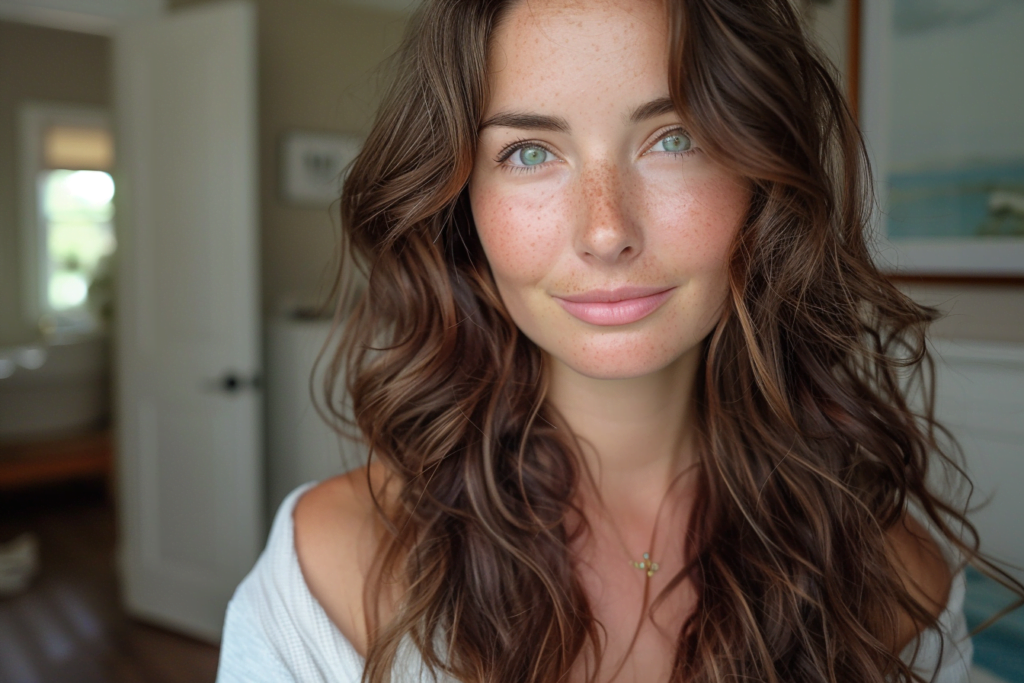“Hair is everything; if only we could think of other things sometimes, but no.
Because that’s when it becomes the difference between a good day and a bad day.”
This quote from Fleabag captures an emotion that many people feel.
It speaks to the powerful role hair plays in life by influencing appearances, moods, and confidence. Whether we like it or not, our hair can dictate how we feel for the rest of the day and this only goes to show its importance in our daily lives and self-perception.
In a world where one’s physical image is considered part of their identity, keeping healthy looking hair automatically transforms into more than just routine—it becomes part of your identity as well as health care to yourself

The link between hair and self-esteem runs deep; if you have had a bad hair day you know what I mean, but then again there are great days.”
Given all these reasons hair deserves our time and effort because healthy hair is not just about beauty – it is about nurturing individuality and happiness.
However, getting to maintain your hair healthy may be very tough due to different types of hairs, conditions among others thus making it hard for you to get confused on which products or treatments would work best for your hair type.’
Moreover, with modern ways on how to manage personal grooming at home, going from having color done on roots to applying DIY facials has made matters worse.
To get shiny strong strands or extend salon visits by few weeks requires understanding some basic principles of good hair care practices”
Some important steps that need to be taken into consideration while selecting your present perfect head wash routine include: finding out what is good for you individually , learning beneficial components , defining the best period when you should shampoo your scalp (as well as treatment options which stimulate growth).
The following tips explain the practical suggestions as well as product recommendations that will guide you through the complexity of caring for your locks thereby enabling you to overcome the obstacles and relish in the triumphs of having hair that you truly cherish and are proud of.
#1 How Often to You Wash Your Hair
The debate about how frequently to wash hair is a hot topic, with opinions ranging widely across the internet.
Some advocate for washing hair every other day, while others recommend a more sparse routine, suggesting no more than once a week. However, the reality is that there is no one-size-fits-all rule that applies to everyone’s hair health.
The key factor in determining how often you should wash your hair is your hair type.

Dhiran Mistry of David Mallett Salon NYC explains that washing daily might dry out hair but adds that there are gentle shampoos with proper moisturizing properties for everyday use without damaging natural oils.
He says girls whose hair is very thin may favor freshly washed, dried strands because they appear fuller and have more texture.
Meanwhile thick-haired people may do it less frequently.
Thicker tresses absorb scalp oils in larger quantities thus staying hydrated for a longer time.
While creating a routine to wash your hair, it is important to understand your hair’s specific needs and traits.
No matter how frequently you decide to wash it, the right shampoo can make a big difference in maintaining its health and appearance.
#2 How Often to Cut Your Hair
Once one split end is formed on a strand of hair, just cut. Dhiran Mistry looks at people who place priority on the length of their hair rather than its health and sameness.
They would normally avoid going for regular trims which leaves their hairs being full and thick near the roots but appearing thin and scanty towards the tips; an imbalance often caused by delayed treatment of split ends or damage.
Mistry argues that such an effort requires more than mere maintenance due to coloring, heat styling, or keratinizing treatments among many others done on a regular basis.
Those people should then trim their hair after every two months so as to maintain its look as well as prevent split ends from advancing while keeping roots thicker than ends.
The only way this can be achieved is through trimming it regularly. Not only does this keep the strands neat in terms of appearance but also keeps them healthy overall, prevents coming up of split ends as well as ensures that from root till tip there is always uniform thickness all through.
#3 If Possible Minimize Heat Styling
According to Mistry (2015), heat styling should be limited only to occasions when you want your hair to stay safe from damages caused by drying and flat irons. For example, blow drying may be done for about five days prior another washing hence allowing a few day break before water touches it again while air drying best suits fine haired individuals.
Water provides a simple solution for women looking for ways of reworking frizzy hair into something manageable again.
Rather than resorting to infrequent use of heat styling tools alone in managing coarse natural textures, better results can be obtained by using products developed to enhance them.
This method allows the hair to be protected in its natural state and hence look better than ever before.
It’s suggested that blow drying is less harmful compared to straightening when one has to style. However, one should opt for the methods and products that reveal their hair’s natural features while using less heat so as to maintain its splendor in a healthy way.
#4 Cold Water Makes Your Hair Shinier
If you want your hair to shine more effortlessly, try lowering the temperature of your shower water. According to Dhiran Mistry, rinsing your locks with cold water after shampooing can help close the cuticle which eventually leads into shinier looking tresses.

To polish it up his suggestion is an application of protective oils, creams and serums that moisten and make strands smoother producing lively looks at the end.
#5 Space Out the Appointments for Hair Coloring
David Mallett colorist Lionel Atlzas advises on spreading out color visits since this will have less impact on your hair including roots or highlights management.
This gives a space for chemical processes used during coloring sessions which do not give hair a break; therefore it makes sense for people who are concerned about their hairs’ health.
Atlas suggests a stable at-home care routine that consists of nourishing and hydrating masks to assist in this recovery.
You can significantly increase your hair’s wellbeing and energy if you use such remedies once per week for around 5-10 minutes.
Apart from spreading out color visits, right shampoo choice is crucial to maintain your hair color.
This is a recommendation that Atlzas is keen on; it proposes the use of shampoos with no sulfates. Sulfates have potentiality of making dyed hair become dull and lose its tone faster.
Choosing sulfate-free formula allows you to keep the intensity of the color longer hence delaying salon visits so as to maintain a healthier looking head of hair.
#6 Hair Loss Can Treatment
Dr. Steven Shapiro, a board-certified dermatologist, points out various options for those with thinning hair. In such cases, people who think of trying prescription medications,
Minoxidil is the only FDA-approved treatment for hair loss in women.
This helps stimulate healthy blood flow to the scalp ensuring that hair follicles receive adequate oxygen and nutrients it needs to grow. When this happens, sleeping follicles wake up and begin producing more hairs than ever before.
Alternatively, Dr. Shapiro suggests going into natural products with saw palmetto berry, green tea extract and caffeine when you are afraid of taking drugs.
These substances have been proven to work against DHT, a hormone responsible for reducing the size of hair follicles hence leading to arrested growth of hairs.
Use these items at home regularly as an alternative non-prescription way of promoting your hair well-being and fighting off baldness.
#7 Health Hair Requires a Good Diet
Dr. Shapiro emphasizes the significant role diet plays in hair health, pointing out how what you consume—and what you avoid—can directly affect your hair. According to him,
Another thing he mentions is that sugar intake increases production of DHT which results into lessening amount of hairs on our heads. Therefore cutting off sugar from your diet is very important if you want to maintain good looking locks.
To keep one’s own curls healthy should be achieved by focusing on a variety of nutritious foods according to Dr. Shapiro.
The examples include protein (which makes up our hairs), vitamin C (that assists us produce collagen and absorb iron) as well as omega-3 fats (very important for having proper scalp).

Moreover minerals and vitamins like iron, B12, folate, biotin or zinc can do wonders if used properly by the person who wants their locks back again.
Particularly low levels of iron; B12; and folate may cause anemia, that in turn leads to low blood flow and poor follicle health and growth. Zinc contains anti-inflammatory elements known to stop the onset of balding.
Finally, Dr. Shapiro advises taking probiotics to improve digestion thus increasing nutrient absorption for proper hair growth. Endeavor to,
This all-encompassing approach towards a proper diet and nutrition is not only beneficial for every aspect of our body but it will also be noteworthy when it comes to maintaining your hair’s condition as well as speed up its growth.


